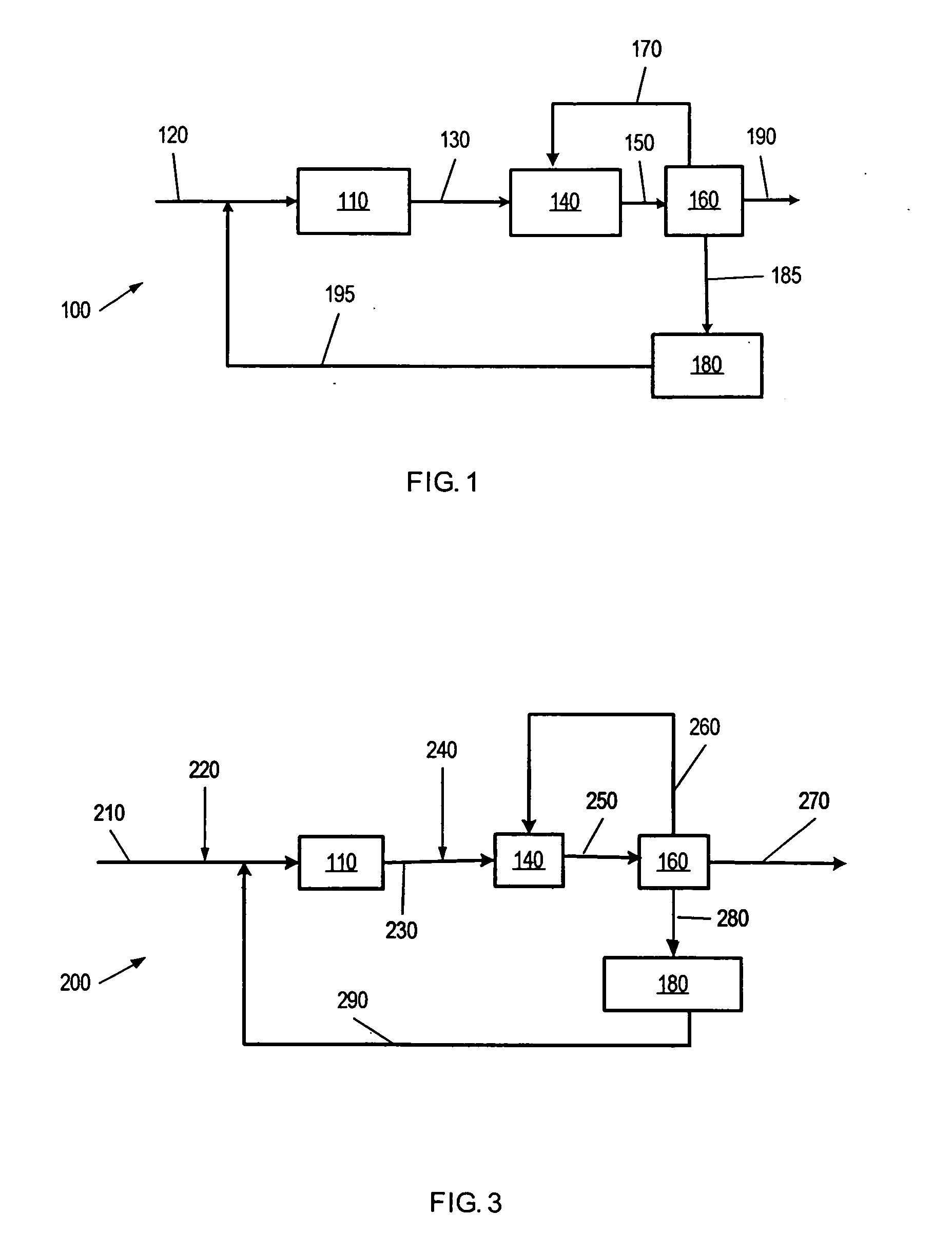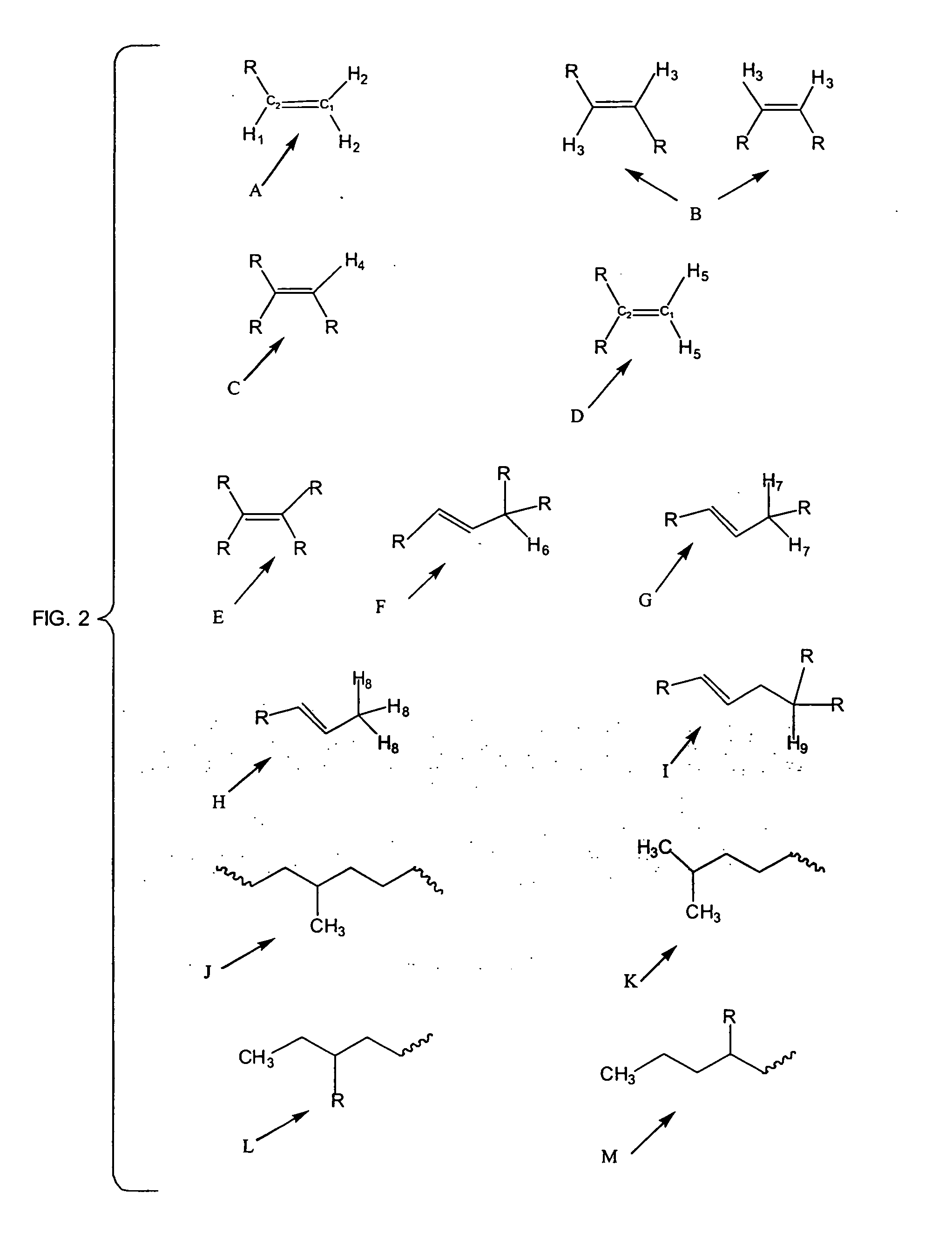Methods of preparing branched alkyl aromatic hydrocarbons
- Summary
- Abstract
- Description
- Claims
- Application Information
AI Technical Summary
Benefits of technology
Problems solved by technology
Method used
Image
Examples
example 1
Isomerization of Olefins in a Fischer-Tropsch Derived Hydrocarbon Stream
[0272] Carbon monoxide and hydrogen were reacted under Fischer-Tropsch process conditions to yield a hydrocarbon mixture of linear paraffins, linear olefins, a minor amount of dienes and a minor amount of oxygenates. The Fischer-Tropsch hydrocarbon stream was separated into different hydrocarbon streams using fractional distillation techniques. A hydrocarbon stream containing olefins and paraffins with an average number of carbon atoms between 8 and 10 was obtained. The composition of the resulting C8-C10 hydrocarbon stream was analysed by gas chromatography and is tabulated in Table 1.
TABLE 1Fischer-Tropsch HydrocarbonStream CompositionWt. %C7 and lighter hydrocarbons0.12C8 branched olefins0.02C8 linear olefins0.751-Octene0.69n-Octane2.21C9 branched olefins0.16C9 linear olefins8.521-Nonene8.07n-Nonane20.03C10 branched olefins0.28C10 linear olefins22.921-Decene20.87n-Decane41.12C11 and heavier hydrocarbons0.2...
example 2
Isomerization of 1-Dodecene: 1-Dodecene was Obtained from Shell Chemical Co.
[0278] The composition of 1-dodecene, as assayed by gas chromatography, is tabulated in Table 3.
[0279] 1-Dodecene was isomerized using the same reactor tube design and isomerization catalyst preparation as described in Example 1. A stream of 1-dodecene was pumped through a reactor tube at a flow rate of 90 g / hr. Nitrogen, at a flow rate of 6 L / hr, was passed over the isomerization catalyst simultaneously with the stream of 1-dodecene. The stream of 1-dodecene was vaporised before contacting the isomerization catalyst. The reactor tube was operated at an outlet pressure of 20 kPa above atmospheric pressure and a temperature of 290° C.
[0280] Table 4 is a tabulation of the weight percent of less than C10, C10-C14 and greater than C14 molecules in 1-dodecene at 0 hours and the reactor tube effluent after 168 and 849 hours. Linear C10-C14 olefins were converted in a 94% yield to branched C10-C14 olefins after ...
example 3
Dehydrogenation of Dodecane with Minimal Isomerization
[0282] Dodecane was obtained from Aldrich Chemical Company and stored under nitrogen before being processed. The composition of dodecane, as assayed by gas chromatography, is tabulated in Table 5.
TABLE 5Dodecane CompositionWt. %Dodecane99.310 hydrocarbonsC10, C11, C13 and C14 hydrocarbons>C14 hydrocarbonsOther C10-C14 olefins
[0283] A paraffin dehydrogenation catalyst was prepared according to Example 1 (catalyst A) of U.S. Pat. No. 4,430,517 to Imiai et al., entitled “Dehydrogenation Process Using A Catalytic Composition”, which is incorporated by reference herein. The resulting catalyst included 0.8 wt. % platinum, 0.5 wt. % tin, 2.7 wt. % potassium and 1.3 wt. % chlorine on a gamma-alumina support. The atomic ratio of potassium to platinum for this catalyst was 16.8.
[0284] The dehydrogenation catalyst was prepared by dissolving substantially pure aluminum pellets in a hydrochloric acid solution. An amount of stannic chlorid...
PUM
| Property | Measurement | Unit |
|---|---|---|
| Temperature | aaaaa | aaaaa |
| Temperature | aaaaa | aaaaa |
| Temperature | aaaaa | aaaaa |
Abstract
Description
Claims
Application Information
 Login to View More
Login to View More - R&D
- Intellectual Property
- Life Sciences
- Materials
- Tech Scout
- Unparalleled Data Quality
- Higher Quality Content
- 60% Fewer Hallucinations
Browse by: Latest US Patents, China's latest patents, Technical Efficacy Thesaurus, Application Domain, Technology Topic, Popular Technical Reports.
© 2025 PatSnap. All rights reserved.Legal|Privacy policy|Modern Slavery Act Transparency Statement|Sitemap|About US| Contact US: help@patsnap.com



